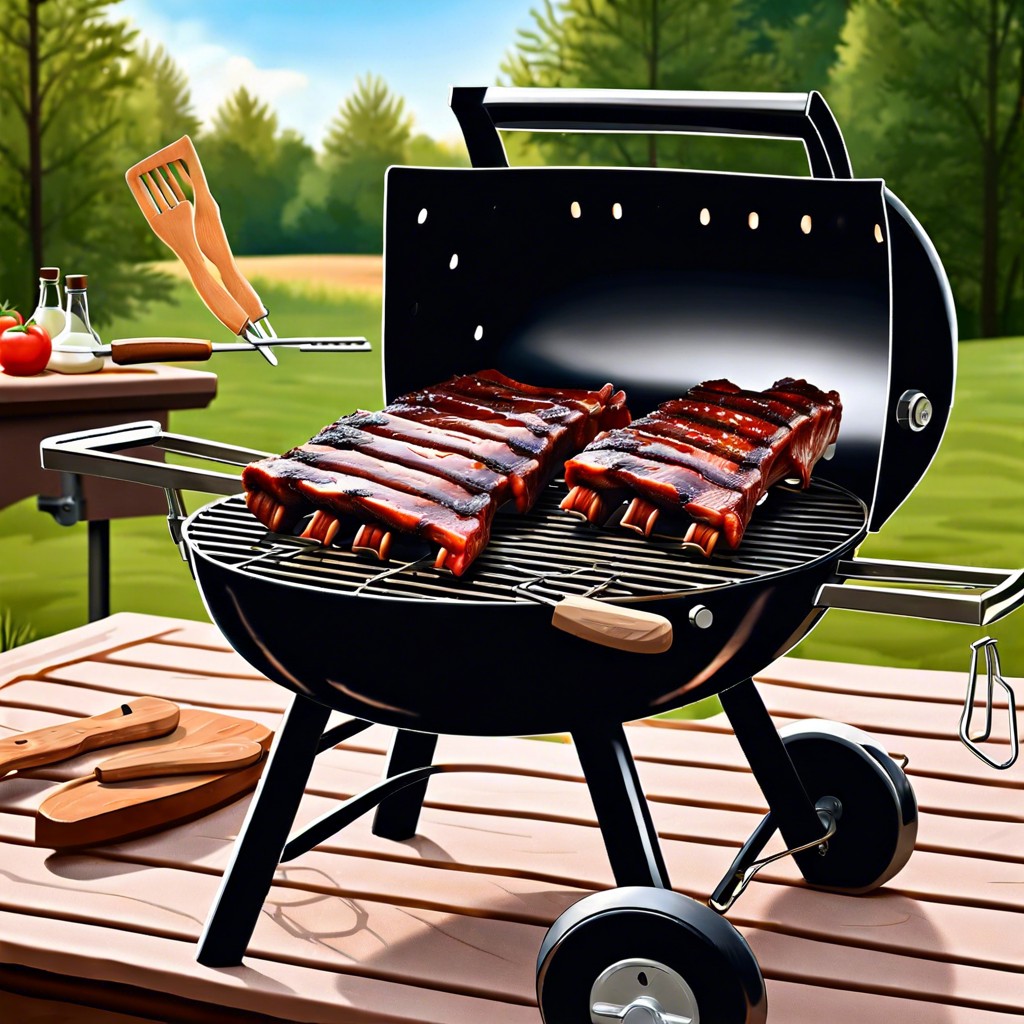This how-to guide provides a straightforward method for barbecuing ribs on a gas grill to achieve that coveted smoky flavor.
Key takeaways:
- Choose baby back or St. Louis-style ribs with good marbling.
- Remove the membrane and slather with mustard and dry rub.
- Set up the grill for indirect heat at 225°F-250°F.
- Use a meat thermometer to measure internal temperature (185°F-195°F).
- Apply BBQ sauce in the last 20-30 minutes of cooking.
Selecting the Right Ribs

When heading to the butcher or supermarket, look for baby back or St. Louis-style spareribs. Baby backs are leaner, cook faster, and are more tender, making them a favorite for many. St. Louis-style ribs are larger, meatier, and have a higher fat content, which can contribute to flavor and tenderness.
Inspect the ribs for even thickness across the rack to ensure consistent cooking. Avoid slabs with exposed bones or ‘shiners,’ as these indicate over-trimming.
Choose ribs with good marbling; the white flecks of fat will melt during cooking, keeping the meat moist and adding flavor.
Meat should appear pink and fresh, not dull or discolored, and the package should be cold to the touch with no tears or damage.
If possible, purchase ribs with the membrane already removed from the back of the rack. If intact, the membrane can be easily removed with a butter knife and a paper towel for a better eating experience.
Selecting ribs with care is pivotal to the barbecue experience, setting the stage for a successful cook.
Preparation of Ribs Before Grilling
Begin by removing the membrane from the back of the ribs to ensure proper seasoning penetration and a more tender result.
Next, slather a thin layer of mustard over the ribs to act as a glue for the rub.
Evenly coat with your choice of dry rub, pressing gently to adhere it to the meat.
Allow the seasoned ribs to sit at room temperature for about 30 minutes before placing them on the grill, harmonizing flavors and ensuring more even cooking.
Setting Up the Grill for Indirect Heat
For gas grill enthusiasts looking to tackle ribs, understanding the concept of indirect heat is pivotal. This creates an oven-like environment, ideal for cooking ribs slowly to tender perfection.
Begin by igniting only one side of the grill, setting it to medium heat, which typically ranges between 225°F and 250°F – the sweet spot for ribs. If your gas grill comes with a built-in thermometer, rely on it to monitor this temperature range. Otherwise, consider investing in a separate grill thermometer.
Leave the burners on the opposite side off. This will be the zone where the ribs cook, away from direct flames, preventing charred exteriors and undercooked interiors. If working with a two-burner grill, the process slightly differs: turn on one burner, place ribs on the opposite side, and manage heat to maintain the desired temperature.
Placement of ribs on the grill is equally important. Layer them across the unlit burners, ensuring each slab has space. This promotes even heat circulation, discouraging flare-ups, and encourages uniform cooking.
Lastly, for those seeking a smoky flavor, wood chips wrapped in foil with punctures can be placed over the lit burner. This introduces a smoky nuance to ribs, brushing them with the essence of traditional wood-fired barbecues. Remember to refill the chips as needed to maintain smoke levels.
By understanding how to wield indirect heat on a gas grill, mastering the art of perfectly barbecued ribs is within reach.
Measuring Internal Temperature
The cornerstone of perfectly cooked ribs on a gas grill is a precise internal temperature. To ensure that ribs are cooked through, yet still succulent and tender, aim for an internal temperature range of 185°F to 195°F.
- Use a reliable meat thermometer to check doneness without cutting into the meat, thus preserving juices and flavor.
- Insert the probe between the bones, as touching bone can give a false high reading.
- Avoid the thinnest parts of the rib rack for the most accurate read on the thicker meat’s temperature.
- Remember that the temperature will continue to rise a few degrees after you take the meat off the grill, known as ‘carryover cooking’.
By maintaining this thermal target, the connective tissues within the ribs break down effectively, creating that sought-after fall-off-the-bone tenderness.
Applying BBQ Sauce At the Correct Time
The final stages of rib grilling are critical for achieving that perfect sticky, glossy layer. Care should be taken not to apply BBQ sauce too early, as the sugars within can burn, resulting in an unpleasant taste.
Instead, wait until the last 20-30 minutes of cooking. Brush on your chosen sauce generously and allow it to caramelize under the grill’s heat, forming a delicious crust.
For even coverage, apply the sauce in a few light layers, letting each slightly dry before the next application. This method not only prevents burning but also builds up layers of flavor that complement the meat’s smokiness.




